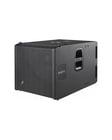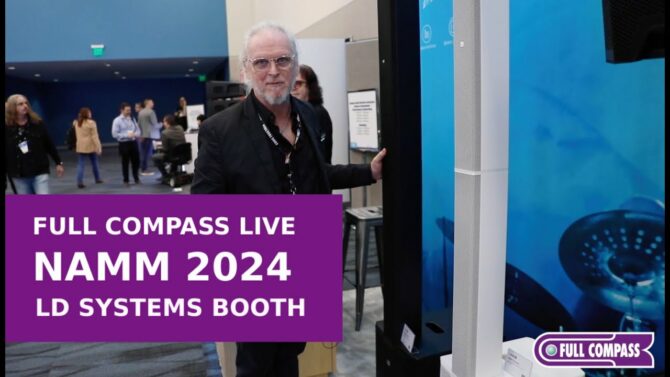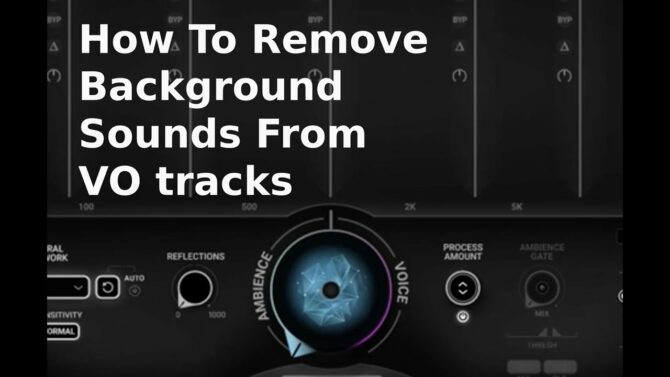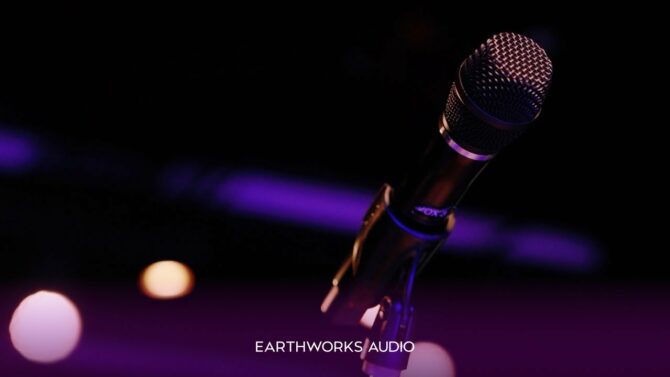DAS is a different kind of company. Located in Spain, it’s a family-owned business that’s been around since 1971. They also design and manufacture the majority of the components used in their systems, which affords more control over the final product, as well as the process used to create it. As a result, their products bring something a little different to the table.
Although many smaller systems are designed for daisy-chaining to handle larger venues, the system being reviewed was designed to be expandable. Using a single Event-26A line array Definition:
Definition:
A vertical array of identical speakers that can have control over vertical dispersion can fill the typical function of a “personal PA” for portable applications, such as demonstrations, conferences, restaurants, hotels, and the like. DJs who want to extend the low end can add the Event-115A subwoofer Definition:
Definition:
A low-frequency speaker, typically optimized for response below 120 Hz, for augmenting full-range sound systems., and still have a very portable setup.
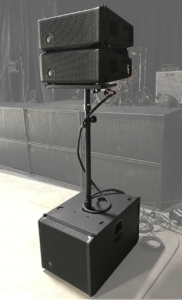
For more power or fixed installations, you can hang up to 16 of the Event-26A line arrays, and another subwoofer. It’s still “portable” in the sense that you can break down the system into the individual components and move them around, but it’s more likely a system like this would find a permanent home in houses of worship, clubs, theaters, auditoriums, and the like. The Event-26A and Event-115A have compatible Definition:
Definition:
Capable of operating with a particular selection of hardware or software. rigging Definition:
Definition:
1. The act of implementing gear for a show, including sound, lighting, scenery, and the like. 2. A mechanical construct of different components used in theatrical productions. systems, so that the Event-26A can be flown from an Event-115A, or stacked above it.
The degree of flexibility is particularly relevant in the current live-sound-challenged environment. For indoor gigs where only a limited number of people can congregate, a presenter or solo acoustic act could take one Event-26A and mount it on a pole. A band or DJ Definition:
Definition:
DJ (Disk Jockey):
1. Traditionally applied to people who played recorded music on the radio or at events. 2. Artists who perform using any combination of pre-recorded music, samples, turntables, and musical instruments. could add an Event-115A to push the bass. A pair of Event-26As with a sub would work for an outdoor venue, or for an even larger venue, four Event-26As with a sub—or double that for stereo Definition:
Definition:
A two channel signal simulating a sound space, typically played through two speakers.. For really large spaces, the rigging hardware (which uses the Fast Set Splay rigging) allows flown arrays with up to 16 units. DAS offers a number of accessories for rigging, stacking, transport, and the like.
Another aspect that works in favor of portability is that it’s lightweight. The Event-26A, with its polypropylene plastic case, is a little over 36 pounds and compact, so one person can do the setup. The sub, with its birch plywood cabinet, is more of a challenge at 89.1 pounds, although that’s comparable to the average 15” sub using a wood cabinet.
What’s in the Event-26A
The Event-26A (Fig. 1) uses a Class D amplifier Definition:
Definition:
1. A device that increases the voltage or power of a signal. 2. In music performance, a device such as a guitar amplifier that includes speakers and controls to increase the sound level of acoustic or electric instruments., with a global-friendly power supply Definition:
Definition:
A device (internal or external to another device) that provides power for active circuitry. Can be AC, DC or battery-powered., that drives two 6.5” transducers and a compression driver Definition:
Definition:
A loudspeaker that compress is motion into a small space to feed the throat of a horn. to provide up to 400 watts continuous/800 watts peak power (and kudos to DAS for giving a continuous power rating, not just peak). Although it doesn’t deliver earth-shaking bass for DJs, the low-end response is pretty much flat down to 90 Hz Definition:
Definition:
See Hertz.. The company claims 100-degree horizontal coverage within -6 dB Definition:
Definition:
1. A deciBel is a logarithmic ratio between two quantities, and is a nonlinear measurement that mimics human perception. 2. A unit expressing sound levels relative to a nominal level just audible by the average human ear, and equal to 1/10th of a Bel., which based on listening tests, sounds about right. The maximum SPL Definition:
Definition:
Maximum SPL (Sound Pressure Level): The maximum amount of level a speaker can generate, or an ear or microphone can accept. at 1 meter is rated at 131 dB.

Regarding connections, input is a female XLR, with a male XLR for daisy-chaining. There are also powerCON Definition:
Definition:
AC Power connector, designed by Neutrik, and rated at 20 Amps. connectors for the AC Definition:
Definition:
AC (Alternating Current): Current whose electrical flow alternates between positive and negative quadrants, and whose magnitude varies periodically. Alternating current is used in most commercial power transmission, and is also the basis of audio or video signals. input and output. The Event-26A is designed for pro applications that assume there will be a mixer Definition:
Definition:
Combiner, controller, and router for multiple audio or video signals. for mics, instruments, line-level sources, and the like.
The internal DSP Definition:
Definition:
1. DSP (Digital Signal Processor): An integrated circuit or device that mathematically alters sound or video signals. 2. DSP (Digital Signal Processing): The technique of converting an analog signal into digital data, manipulating that data, then producing an analog output that reflects the changes caused by these manipulations done in the digital domain. is utilitarian; you won’t find features like Bluetooth Definition:
Definition:
A short distance (less than 33 feet) wireless data transfer standard. for a remote Definition:
Definition:
A broadcast from the field, not from the studio. A Remote Control. app, or selector switches designed for easy setup in particular scenarios (e.g., a switch for DJ, speech, music, etc.). However, the DSP also handles EQ (not user-adjustable, but designed to equalize correctly for different numbers of units), user-adjustable delay up to 9.9 ms, internal limiter Definition:
Definition:
A form of compressor with a ratio of infinity:1 above the threshold for both overload protection, or as a sound effect to normalize volume. Some engineers consider a compressor with a ratio of 20:1 or higher above the threshold a limiter., and a phase-linear FIR-based crossover Definition:
Definition:
A filter or set of filters that divide audio signals by frequency. Crossovers, whether active or passive, are common in speaker designs to direct high and low frequencies to their respective drivers. Crossovers are also used in multiband signal processors, like multiband dynamics or multiband distortion. . The latter improves transparency not only with an individual Event-26A, but also when hanging multiple units.
The LCD-driven DAScontrol interface takes advantage of the DSP to simplify preset Definition:
Definition:
1. (verb) Ability to set parameters in advance, and recall those parameter values as desired. 2. (noun) A collection of parameter values stored within a device, or externally. selection for the number of units in an array. You push a knob, dial in the number of units (1, 2, 4, 6, 8, or 12), choose whether DownFill is on or off, optionally set up delay, and you’re ready to go. The LCD Definition:
Definition:
LCD (Liquid Crystal Display): A display that uses fluid crystals that can block, reflect, or transmit light from a back illuminator, and uses very little power. shows input and output levels to avoid overload Definition:
Definition:
Causing a device to exceed its capability, usually undesirable but used for an "overdrive" effect in music. Also called 'Blooming" in classic recordings. See Overdrive. conditions, but note that you can also select an LCD dim mode for darkened venues (but it can be set to flash in overload conditions).
What’s In the Event-115A Subwoofer
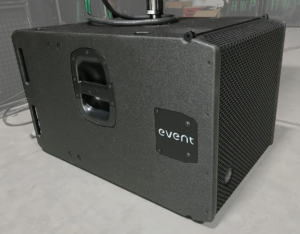
Based on a 15” woofer Definition:
Definition:
A low-frequency driver or speaker. with an extended 3” voice coil Definition:
Definition:
A coil of wire attached to a loudspeaker cone or diaphragm around a stationary magnet. Applying current to the coil moves the speaker., the Event 115-A (Fig. 2) delivers 600 watts continuous/1200 watts peak via a Class D amplifier. There are the same XLR and AC powerCON connectors as the Event-26A, and the same DAScontrol to simplify setup.
There’s not much else to say about a big box with intelligent thermal design, DSP, and a 15” speaker—hey, it’s a subwoofer. But if you need big bass to complement the Event-26A, this is the ticket.
Under Test
I ran two test scenarios. One was a single Event-26A in my home studio Definition:
Definition:
A recording studio located in a residence that may be dedicated to a hobby, or to commercial projects. See Project Studio. environment to see how it would work for presenters and small musical acts. My first impression was that the Event-26A is both loud and clean—to a surprising degree given the size and weight. It’s also quiet; a fan kicks in if the amp Definition:
Definition:
Abbreviation for either Ampere or Amplifier. starts running hot, but you need to work it hard to keep the fan on. The lack of response below 90 Hz wouldn’t matter for a presenter, pastor, or a singer-songwriter act, but could be a limitation for club DJs. It might not be as much of a limitation for mobile DJs if they use equalization to boost the bass.
The second, more “rubber-meets-the-road” test was conducted at High Wire Productions in Tennessee. The company specializes in event/venue needs including live sound, installs, rentals, lighting, and bookings. They were also one of the early adopters in downtown Nashville for line array-based installations.
High Wire had recently started switching much of their gear from another company’s speakers to DAS, and I was curious to find out why—my sense is that DAS flies a bit “under the radar.” The system under test at their facility (where I could really crank up the levels) was stereo, with two Event-26As and one sub per channel Definition:
Definition:
1. In radio, television, citizen's band radio, and other wireless communications modes, a specific frequency for communication. 2. In mixers and video, an input or output signal path with controls. 3. In MIDI, one of 16 data paths..
No EQ or other processing was added, and without it, the “native” voicing was more like a studio monitor. I found it a little on the bright side, but without harshness. In a venue filled with people, those highs would likely be necessary. The transient response Definition:
Definition:
The ability for a piece of equipment to follow a fast-rising waveform, and reproduce it accurately. was notable—there was no smearing I could hear. This was true of both acoustic sounds from material recorded in a commercial studio, and electronic sounds recorded in my home studio that I brought for testing.

High Wire usually runs subs from a separate bus for flexibility, but I wanted to evaluate solely how the “out of the box” system worked. With the subs connected in “Loud” mode, the sound was basically that of the Event-26A with a significant bass extension. “Deep” mode delivered the satisfying subwoofer “thump” associated more with DJ and club applications.
When asked why they had switched to DAS, the company mentioned that they weren’t enamored of older DAS products, with the exception of the floor wedges—which were so good they were willing to give the new systems a try. Sound was the primary consideration, but also, High Wire is a company that lives and dies by reliability and ease of rigging (Fig. 3). For what they do, they felt the Event-26A and S-115A sub ticked all the boxes—sound, ease of use and setup, transportability, reliability, the ability to accept being pushed hard, and support. Certainly by my standards for sound quality, the Event-26A and S-115A delivered.
The Takeaway
Systems for making loud noises in big places are not exactly an endangered species these days, so let’s see what DAS brings to the party.
A notable aspect of the Event-26A is how it works as a system in conjunction with other Event-26A units, as well as the Event-115A subwoofer. The rigging method is simple and intelligent, while the DAScontrol—although basic—simplifies setup with different systems. In a scenario where different events and venues require systems with varying amounts of Event-26A units and subs, these are important points.
For pro applications, both units have a no-nonsense vibe. They’re not “consumer” products per se, although they can fulfill that function. Instead, they seem best-suited for situations where you need a system you don’t have to think about, can carry easily from place to place, make available for rentals, and expand or downsize as needed. The price is certainly competitive, even with the eroding dollar compared to the euro.
Overall, DAS has found a need, and filled it. Positioned between portable and permanent, but able to do either one, the end result is a system that delivers quality sound, yet is sufficiently versatile to be at home in a variety of contexts.





